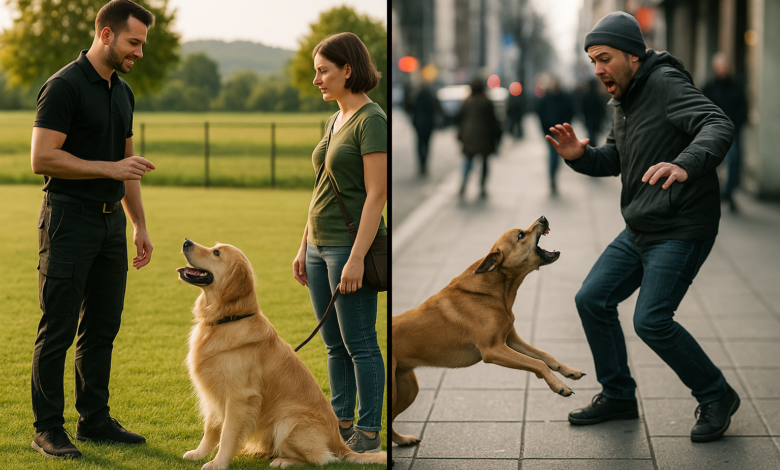We may earn a commission when you click on links across our website. This does not influence our opinions — learn more.
Could Switzerland’s Approach to Dog Training Reduce America’s Rising Dog Bite Problem?

Dog bite incidents in the United States have surged to crisis levels, prompting renewed debate over how best to protect communities while supporting responsible pet ownership. One country offers a compelling case study: Switzerland.
Through a combination of mandatory training in many cantons (similar to a state in the U.S.), strict welfare standards, and cultural norms around responsible ownership, Switzerland has achieved dog bite rates more than ten times lower than those in the U.S. — a striking difference that raises important questions about how American communities could follow suit.
Dog Bites in America
In 2024, American dog bite incidents reached unprecedented levels, with 4.5 million people bitten annually — approximately one bite for every 73 Americans.
A preliminary CDC report suggests 2024 could see 113 dog bite deaths, the highest number ever recorded.
U.S. insurers paid out a record-breaking $1.57 billion on 22,658 dog-related injury claims in 2024, representing an 18.9 percent jump from the previous year, and average claim costs soared to $69,272.
Specific Las Vegas data underscores the local impact: Clark County Animal Protection Services reported about four dog bite incidents per day, with 384 bites in Q2 2024 and 376 in Q3 2024, illustrating a troubling trend that mirrors the national crisis.
Switzerland’s Approach
Switzerland reports roughly 9,500 dog bites requiring medical attention each year among a population of about 9 million and 560,000 dogs — about one bite per 950 people.
In contrast, the U.S. experiences 4.5 million bites among 335 million people, with over 800,000 requiring medical treatment.
While multiple factors — such as urban design, cultural attitudes, breed mix, enforcement practices, and reporting standards — contribute to this disparity, Switzerland’s comprehensive training culture aligns with bite rates more than ten times lower than those in America.
From 2008 to 2016, Switzerland maintained a nationwide mandatory training program, which was later repealed and enforcement left to the discretion of each canton,
Since June 2025, the canton of Zurich has reintroduced compulsory theory courses and certification exams for first-time dog owners.
This program covers canine behavior, basic training techniques, owner responsibilities, health requirements, and the financial and practical commitments of dog ownership.
After passing the theory exam, owners attend six practical sessions focusing on obedience, socialization, leash handling, and humane interaction with certified trainers.
Swiss animal welfare laws also mandate daily companionship for dogs, recognizing them as social animals with emotional needs.
Dogs cannot be left alone all day and must have regular contact with humans and, where possible, other dogs.
Some cantons also restrict ownership of certain breeds, complementing training requirements with targeted regulations.
Evidence Supporting Education and Training
Research consistently demonstrates the effectiveness of education-based prevention programs.
A study in pediatric emergency departments found that video-based dog bite prevention programs increased children’s knowledge from 58 percent to 90 percent pass rates. These programs effectively teach kids to recognize high-risk situations, such as approaching stray dogs or dogs that are eating.
Training methodology also matters significantly. Studies comparing reward-based and aversive training methods found that dogs trained with positive reinforcement exhibited better welfare outcomes and fewer behavioral problems, while punishment-based methods correlated with more problematic behaviors.
Switzerland’s system provides a real-world example of how mandatory training and welfare standards can align with dramatically lower bite rates at the population level, even though no formal longitudinal study isolates training laws as the sole causal factor.
The American Training Gap and Local Context
In the U.S., only 30.7 percent of dog owners attend formal training, leaving many owners without essential skills in canine behavior and safe handling.
Children, who account for 50 percent of bite victims, are particularly vulnerable to severe injuries.
Nevada illustrates these challenges: although 53.3 percent of households own pets and the state ranks fifth nationally for devoted dog owners, there are no mandatory training requirements.
Current Nevada law focuses on post-incident reporting rather than proactive education.
Building a Preventive Model
Comprehensive owner education would ensure that every prospective dog owner understands canine behavior, training principles, legal responsibilities, and welfare needs before licensing.
Courses could cover reading canine body language, positive reinforcement techniques, local leash and licensing laws, and the emotional needs dogs have for daily companionship, embedding prevention at the start of ownership.
Hands-on training sessions with certified professionals would give owners the practical skills to manage their dogs safely in real-world situations.
Structured classes would include obedience cues, socialization exercises, and leash handling under expert guidance, directly addressing behavior problems before they escalate.
Shifting from reactive enforcement to proactive education amplifies impact. Community-wide prevention initiatives — such as school-based workshops and public awareness campaigns — have been shown to improve knowledge and safe behavior around dogs, reducing bite incidents before they occur.
Complementary regulations, such as breed-specific ownership guidelines and centralized reporting standards, would enhance the framework’s effectiveness.
By combining mandatory training with targeted breed rules and reliable incident data collection, authorities can tailor interventions to emerging trends and allocate resources more strategically.
Pilot programs in high-incident areas like Clark County could demonstrate the model’s effectiveness.
Dog-friendly Las Vegas, with its strong pet culture and progressive welfare laws, offers an ideal environment to trial these initiatives and gather data to inform wider adoption.
The Cost of Inaction
Ignoring preventive measures comes at a high price. Dog bite claims have increased 48 percent over the past decade, and average payouts have risen 18 percent annually.
Beyond financial costs, the human toll — especially on children who suffer serious facial injuries — demands immediate attention.
While causation cannot be attributed solely to training laws, Switzerland’s experience shows that mandatory education, practical skills training, and welfare standards can coexist with vibrant dog ownership and align with bite rates over 90 percent lower than those observed in the U.S.
As record-breaking incidents and soaring insurance costs continue, the Swiss model offers evidence supporting a path toward safer communities and more responsible pet ownership.
For dog owners in Las Vegas looking ahead, numerous certified training programs are available throughout the valley. Investing in proper training today not only enhances the bond with your dog but contributes to the safety and well-being of the entire community.



